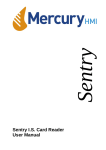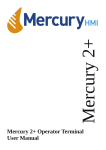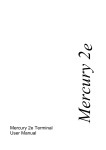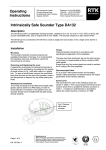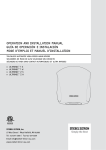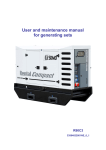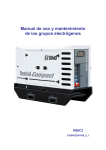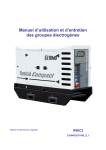Download Sentry I.S. Card Reader User Manual
Transcript
Sentry Sentry I.S. Card Reader User Manual Special Conditions The Sentry Cardreader has special conditions for safe use (denoted by X after the certificate number) applicable to it. There are 2 conditions applied, see section 15 of the Sira Certificate shown on page 30. Mercury HMI Ltd explanation of the special conditions for safe use: 1. The Sentry Cardreader has areas of the enclosure that could generate static under some circumstances, and if the static were to build up then a spark could result. To avoid this risk, do not clean or polish the device with a dry cloth or position it where jets of highpressure steam or other gases could blast over its surface. 2. This is a warning that the enclosure is made of LM24 grade Aluminium, and there is the potential for sparking to occur by impact or friction from objects hitting it. Therefore position/protect the unit so that it is unlikely to be struck. 2015r0 Page 2 of 37 Sentry IS Card Reader User Manual Contact Mercury HMI Ltd George House Derwent Road Malton North Yorkshire YO17 6YB UK Tel: Fax: Email: Web +44 (0) 1653 697 200 +44 (0) 8700 667 325 [email protected] www.mercuryHMI.co.uk All trademarks are acknowledged as the property of their respective owners. This document shall not form part of any contract. Specifications are subject to change without notice, and Mercury HMI Ltd accepts no liability of any kind for errors or omissions. Sentry IS Card Reader User Manual Page 3 of 37 2015r0 Revision History Rev 1.0 1.1 2.0 27 Jul 09 2.1 2.2 6 Oct 09 2 Dec 10 2.3 2014r0 18 Mar 11 11 Nov 14 2015r0 1 Jul 15 2015r0 Date Changes Original Release Mercury IMC Version Substantial revision of the manual, for Wiegand O/P Mode, R507 barrier and Modbus enhancements. All drawings redrawn The Digital Output driving page 17 has been revised. Table boundaries made finite thickness, to help PDF printing Extra reader type added Config string updated Links show Mercury HMI limited & logo. Certificate checked. Added Special conditions of use Substantial revision of the manual Added GRP case information Added LED cable orientation Fixed Modbus coils Add Wiegand Output mode wiring diagram for Pepperl & Fuchs barriers Page 4 of 37 Sentry IS Card Reader User Manual Contents Introduction........................................................................................................................6 Certification Standard...................................................................................................... 8 Installation..........................................................................................................................9 Overview............................................................................................................................. 9 Mounting the Sentry Card Reader....................................................................................... 10 Weatherproofing.................................................................................................................. 10 Hazardous Area Connections...............................................................................................10 Safe Area..............................................................................................................................11 Safe Area Connections.........................................................................................................12 Internal Overview................................................................................................................ 12 Operation............................................................................................................................13 Power On............................................................................................................................. 13 Set Up & Configuration.......................................................................................................14 Configuring the Reader Card Type......................................................................................14 Operating Mode................................................................................................................... 15 Configuration String............................................................................................................ 16 Example Configuration String.............................................................................................17 Telemetry Block Structure................................................................................................ 18 Escape Sequences................................................................................................................ 19 Card Data ............................................................................................................................ 19 System Options.................................................................................................................. 20 Option 1 : IS Sentry in Standalone mode........................................................................... 20 Option 2 : IS Sentry in MultiDrop Mode........................................................................... 20 Option 3 : IS Sentry in (standard) Modbus Mode............................................................... 21 Option 4 : IS Sentry in Mercury 2+ Modbus Compatibility Mode..................................... 23 Option 5 : Safe Area Sentry................................................................................................. 24 Option 6 : Wiegand Output Mode....................................................................................... 25 Hazardous Area I/O...........................................................................................................26 Appendix A Wiring Diagrams........................................................................................... 27 Appendix B Card Technologies........................................................................................ 35 Appendix C Specifications................................................................................................36 Appendix D Link Settings.................................................................................................37 Sentry IS Card Reader User Manual Page 5 of 37 2015r0 Introduction The Sentry Card Reader is a modular and highly configurable unit designed to read a variety of different card types in Hazardous Areas. A complete Sentry Card Reader unit comprises of three main components, and there are several versions of each of these main components: 1) A power and communications safety barrier, or galvanic isolator, mounted in the Safe Area when the Sentry Card Reader is to be used in a Hazardous Area installation. 2) The Sentry base unit, with the processing and communications electronics affixed in the Hazardous Area, connected to the fixed wiring. 3) The Sentry lid, containing the appropriate reader head (the reader electronics and a safety barrier encapsulated together into a module mounted behind the RF transparent window) and the status LEDs. There are three power and communications types available: 1a) For a Safe Area Sentry, the unit can be connected directly to a power source and the communications can be connected directly to a PC, PLC or DCS as needed. 1b) For a Hazardous Area Sentry, requiring serial communications within the Safe Area, then an R507 Interface Module is needed. 1c) If Wiegand D1/D0 communications is needed from a Hazardous Area mounted Sentry Card Reader, then a Safe Area mounted P510 Module together with a pair of standard zener barriers is needed. Mercury HMI recommend the use of MTL or Pepperl and Fuchs barriers, but other manufacturers can be accommodated. There are then three variants of the Sentry base units: 2015r0 2a) Safe Area Serial Communication version. This requires a clean 24V power supply and provides RS422 or RS485 communications. 2b) Hazardous Area Serial communications version, supporting point to point, multidrop and Modbus communications. An R507 Interface Module will be required in the Safe Area. Page 6 of 37 Sentry IS Card Reader User Manual 2c) Hazardous area Wiegand Output Version. A Wiegand Output kit comprising of a P510 Module and barriers is also needed. Currently there are three different Sentry lids available: 3a) EM Proximity Card. The Sentry Card Reader is able to read the EM4001 and EM4100 range of cards. These were originated by EM Microelectronic Marin of Switzerland, and now widely manufactured. Although there is no central control of the numbers, the 40 bit number allows more than a trillion (1012) card numbers. The EM cards read cycle is reliable and fast and the range is around 50mm. 3b) MIFARE Proximity Card. The MIFARE card from NXP was originally designed for rapid transit electronic billing. The cards contain secure memory and can be used as an electronic "purse". However note the Sentry only reads the 4 or 7 byte Unique ID (or Card Number). No write operations are possible in the hazardous area currently. 3c) HID Proximity Card (125kHz). HID provide a huge range of card formats, and there are certain types that cannot be read by the Mercury HMI Sentry card reader. Contact the factory for more information if you require an HID solution. See Appendix B for more information on the different card technologies. Illustration 1 : Sentry Card Reader Sentry IS Card Reader User Manual Page 7 of 37 2015r0 Certification Standard ATEX Number The SIRA certification No. 99ATEX2138X shows EEx ia IIC T4, which is made up as follows: EEx = European certificate for Hazardous Areas. ia = Intrinsically Safe for Zone 0, continuous Hazardous vapours. IIC = Safe for ALL gas groups. T4 = Component surface temperature cannot exceed 130°C, i.e. safe for all gasses except carbon disulphide. The “Conditions of Certification” show the maximum parameters of each of the input/output terminal blocks. Nomenclature & Conventions In this manual, ASCII single characters which are either control or nonvisible codes (Hexadecimal 00H 1FH, 20H and 7FH) are indicated by enclosure in <>, for example, <ESC>. Character strings which are indivisible sequences are shown between quotation marks, for example, "<ESC> [ 2 J". In the ASCII 7 and 8 bit code sets used by the Sentry Card Reader, a character is represented by two digits, each in the range hexadecimal 0 to F. For example, <SP>, the space character is defined (20H). 2015r0 Page 8 of 37 Sentry IS Card Reader User Manual Installation Installation Overview The Sentry Card Reader has ATEX approval for use in Hazardous Areas when used with the R507 Interface Module or a direct equivalent. The Intrinsically Safe Interface Module provides galvanic isolation between the 24V D.C. power & host communication ports and the I.S. Hazardous Area connection. These connections to the Sentry allow a cable length of up to 1km (when used with an R507) or 500m (when in Wiegand D1/D0 mode). The R507 communication ports provide for RS232 and differential transmit and receive terminals for RS422/485, with tri state control. The Sentry should be ordered as a complete unit comprising base unit and appropriate lid as required. The Sentry can then be mounted on any convenient flat surface using the four holes provided. The dimensions of the box are shown in the diagram below. Illustration 2 : Sentry Mounting Hole Centres Sentry IS Card Reader User Manual Page 9 of 37 2015r0 Mounting the Sentry To affix the Sentry Card Reader to a surface, prepare by drilling four holes 204 mm apart in width and 82 mm apart in height, refer to Illustration 2. Carefully remove the Sentry Lid containing the reader head and LEDs, supporting the lid so that the cables are not put under strain. If this is not possible, carefully remove reader head plug from J2 (see Illustration 4) and the LED assembly plug from J1 and store the reader head safely. Four mounting screws can now be used to attach the Sentry Base Unit to the mounting surface. Now plan how the hazardous area wiring is going to be terminated. For a simple IS installation, when the only connections are the 4 wires to the Sentry, use the left hand gland. Weatherproofing The Sentry Card Reader is weatherproof, but care must be taken to ensure the “O” ring seals are in place and free from grit when mounting the equipment. In salty or corrosive areas, it is advisable to grease the lid screws to avoid binding. Alternatively, the GRP enclosure may be a better choice as it offers better protection, especially in marine environments. There are three 20mm threaded holes provided in the box for cable glands. Two gland holes are provided with blanking plugs, the other gland must be provided by the customer. In its most basic configuration, Sentry wired to host, only one cable is needed (See Appendix A drawing number P174’112 and P174'113). Hazardous Area Serial Connections For hazardous area applications, the cable connecting the R507 power and communications interface needs to comply with the following parameters: Loop Resistance Capacitance L/R Ratio Inductance 40 Ω Maximum 142 nF Maximum 33 μH/Ω Maximum 0.6 mH Maximum In practice these parameters are easily met by standard cables; e.g. a 1 mm2 quad cable has approximately the following parameters: Loop Resistance Capacitance L/R Ratio Inductance 38 Ω/km Maximum 55 nF/km Maximum 2.5 μH/Ω Maximum 0.48 H/km Maximum For a cable length of 1km, this would satisfy safety and operating requirements. 2015r0 Page 10 of 37 Sentry IS Card Reader User Manual Safe Area Requirements For hazardous area use, the Sentry must be connected to the R507 power and communications interface. The R507 must be located in the Safe Area. An illustration of the interface module, which is designed to be mounted on a DIN rail, is shown below: Illustration 3 : R507 IS Power and Comms Isolator Sentry IS Card Reader User Manual Page 11 of 37 2015r0 Safe Area Connections For Safe Area use, the hazardous area parameters are not applicable and any suitable communications cable can be used. In a Safe Area application, the host can be connected directly to the Sentry card reader RS422 connections as shown in Appendix A. The wiring terminals are screw terminals on a 5.08 mm pitch; each capable of accepting 2mm diameter cores or ferrules. For connection details of power and signals, see the wiring diagrams in Appendix A. Internal Overview Illustration 4 shows an overview of the key internal components and connections. It should be noted that, due to space limitations, the connector used for J1 does not use a 'keyed' plug. As such, it is possible to connect the socket the wrong way round. The correct orientation is with the small plastic lugs pointing away from R1 ... R3 and towards the closest edge, as follows: Illustration 4 : Inside view of the Sentry, showing key components and connections 2015r0 Page 12 of 37 Sentry IS Card Reader User Manual Operation Power On Assuming the device is correctly wired, when the 24V power is applied to the R507 power and communications interface, the Power/Comms LED Indicator (the uppermost one) will alternate between RED and GREEN whilst the other indicators will flash RED. Illustration 5 : Showing the LED indicators Once the unit has performed its startup tests, the Power/Comms LED Indicator is illuminated Green to show the unit is powered and ready for operation. When a proximity card is within the RF field, the Card Present LED will be illuminated. Once the card has been successfully read, the data from the card is decoded, and then sent back to the Safe Area where it is available from the barrier and communications interface in Serial RS232/422/485 format as ASCII characters. The Power/Comms LED Indicator briefly changes colour (from GREEN to RED) to indicate the card data has been successfully decoded and transmitted. The Host Programmable LED can be set to be On, Off or Flash, utilising commands sent using the serial communications channel by the host to which the Sentry Card Reader is connected. Note: although this LED is fitted to all models, it cannot be controlled in Wiegand output mode. Sentry IS Card Reader User Manual Page 13 of 37 2015r0 Set Up & Configuration With the equipment suitably connected, the Sentry can then be configured for use. The factory default settings are: Baud Rate: 9600 Word Length: 8 Stop Bits: 1 Parity: None Telemetry Mode: PointtoPoint Output Structure: Data Only Start/stop bit operation: Wiegand cards Proximity cards Start = 1, stop = 0 Include parity bits To change the default set up, the links LK5 and LK6 in the Sentry unit should be changed accordingly and then the new set up downloaded to the Sentry. The link configurations are shown in section Operating Mode. Configuring the Reader Card Type NOTE: For correct operation jumper links LK2 and LK3 on the card reader main board must be set to correspond with the type of card reader head fitted as follows: Card Reader Type Proximity Reserved (used for old HID) Legacy EM (Byte reversed) Legacy Wiegand LK3 Off Off On On LK2 Off On Off On The Card Reader Type link settings will be correct when the unit is received from the factory and only needs changing if the lid is changed for a different card technology. The board must be restarted for these settings to take effect. 2015r0 Page 14 of 37 Sentry IS Card Reader User Manual Operating Mode The card reader has various modes of operation. This is determined by the position of bit links LK6 and LK5 at start‑up: Operating Mode Run as Configured Reserved (for future use) Load New Configuration Run as Default Configuration LK6 Off Off On On LK5 Off On Off On Illustration 4 shows the locations of the links on the main Sentry PCB together with their functions. The “Run as Configured” mode configures the Sentry Card Reader using the last stored user configuration. The "Run as Default Configuration" mode overrides any user configuration, and hence gives a known setup to allow communications to be established. The “Load New Configuration” mode also starts the card reader with the default settings loaded, but in addition it allows new configuration data to be uploaded to the card reader for storage in nonvolatile memory. This user defined new configuration data is then only used when the card reader is restarted with bit links set for “Run as Configured” mode. A configuration string is uploaded to the card reader via the communications port using any ASCII terminal. This is initiated by the keyword “config” followed by the configuration data itself. The configuration string must be terminated by the “@” character to invoke a transfer from the input buffer to nonvolatile memory. Mercury HMI Ltd also provide a simple Windows program that can be used to configure the Sentry. Please contact Mercury HMI for more details. Sentry IS Card Reader User Manual Page 15 of 37 2015r0 Configuration String The configuration string uses the following format: config<baud rate>,<parity>,<word length>,<stop bits>; <telemetry mode>[,<telemetry address>];<output structure>;<multidrop acknowledge>;<start/stop bit operation>;<reverse data>;<data byte count>@ Available options are shown in the table below (bold values denote the default setting): Parameter Baud Rate Option 1200, 2400, 4800, 9600, 19200 Parity None, Odd, Even, Mark, Space (sent as n, o, e, m, s) Word Length 7, 8 Stop Bits 1, 2 Telemetry Mode PointtoPoint (sent as pp) Mercury Multidrop (sent as md) Modbus (sent as mb) Mercury 2+ Modbus (sent as m2) Telemetry Address 1 to 64 Note : omit this if configuring as Point toPoint mode Output Structure 0 (Data Only), 1 (Mercury Multidrop Format) 2 (Data + <ETX>) Multidrop Acknowledge Disabled (sent as 0) Enabled (sent as 1) Multimode Start / stop bit operation In Proximity mode: Include start / stop parity bits (sent a 0) Strip start / stop parity bits (sent as 1) In Wiegand mode, this detects: Start bit = 1, stop bit = 0 (sent as 0) Start bit and stop bit opposite polarity (sent as 1) 2015r0 Reverse data Disabled (sent as 0) Enabled (sent as 1) Data byte count 2 byte value denoting the number of data bytes to be output. The data is padded or truncated as required. If the default value '00' is used, the original card data is output. Page 16 of 37 Sentry IS Card Reader User Manual Example of Configuration String config9600,n,8,1;md,12;0;1;1;0;00@ After loading this string into nonvolatile memory the card reader immediately reads it back and transmits it to the host terminal (with the Sentry base unit PCB serial number appended) to confirm success of the write. For example, the user would see: config9600,n,8,1;md,12;0;1;1;0;00 Serial #:00000123 Once the string is uploaded, the user should: 1. 2. 3. Power off the card reader for 5 seconds. Change the links to ‘Run as Configured’ mode. Power on the card reader. Alternatively, for Windows users, there is a simple test and configuration package available for free download from the Mercury HMI website. The picture below shows the view of the configuration tab. Sentry IS Card Reader User Manual Page 17 of 37 2015r0 Telemetry Block Structure Multi Drop When Mercury Multidrop output format is selected, messages between the Card Reader and host follow the format: “<STX>, ADDR, FUNC, ID, DATA, DMY, CSUM, <ETX>" <STX> is the Start Transmission character (02 Hex) ADDR is a twobyte address field. Each byte is the ASCII equivalent of a number 0 to 9. This number is not relevant except in multidrop mode. It is the Telemetry Address and can take the value 01 to 64. FUNC is a single byte character used to determine the type of information being sent. It is always “D” (44 Hex) when transmitted from the card reader, and “R” (52 Hex) when transmitted to the card reader. ID is the identification of the source of the block. It is a single byte used to distinguish between the various sources of block data. Possible values are: 'B' (42 Hex) if the block contains Wiegand card swipe data. 'E' (45 Hex) if the block contains Digital Input data. 'G' (47 Hex) if the block contains Proximity card swipe data. 'V' (56 Hex) if the block contains Software Version data. DATA is the field used to send information. DMY is a single character whose value is chosen to ensure that the following CSUM byte is not a control character. The value of DMY is usually 00 Hex but if this would result in the CSUM being a control character the DMY would be set to 20 Hex CSUM is a single byte checksum character. This is the 7 bit negated algebraic sum of all the characters in the string from the STX up to and including the DMY byte. <ETX> is the End Transmission character (03 Hex). Data Only 2015r0 If “data only” is selected as the output structure, only the hex ASCII data is output, with no header or trailer characters. Page 18 of 37 Sentry IS Card Reader User Manual Escape Sequences The Card Reader responds to the following escape sequences, which are a subset of those used by a Mercury Terminal: Send Next Queued Block: (Multidrop mode only) “<ESC>[?9;1z” ReSend Last Queued Block: (Multidrop mode only) “<ESC>[?9;2z” Enable Card Reader in One Shot Mode Disable Card Reader: Enable Card Reader: “<ESC>[?15;4z” “<ESC>[?15;5z” “<ESC>[?15;6z” Note: these commands enable / disable the device regardless of the card media type it is configured to read. Card Data Sample Dig Ins: “<ESC>[?4z” Set Dig Outs: where n is one of the following: n Dig Out #1 Dig Out #2 0 On On 1 Off On 2 On Off 3 Off Off “<ESC>[?5;nz” Read Config: which returns the configuration data string and serial number. “<ESC>[?2z” Set Host LED: Clear Host LED: Flash Host LED: “<ESC>[?6;1z” “<ESC>[?6;2z” “<ESC>[?6;3z” Read Software Version “<ESC>[?6;0z” Proximity Cards: Data Length – 26 or 32 bit cards (6 or 8 characters transmitted from card reader) Note that other formats may be supported. Please contact the factory for further details. Sentry IS Card Reader User Manual Page 19 of 37 2015r0 System Options There are a number of different ways the Sentry Card Reader can be used depending upon the requirements of the particular system. The following information describes some of these system options regardless of the type of card reader used as this is incidental to the system involved. Option 1 IS Sentry in Standalone Comms mode To operate in this mode, the Telemetry Mode in the configuration string has been set to "pp" or the Sentry is running in it's default mode. This is a very straightforward system option. The Sentry is connected by a fourcore cable directly to the R507 in the safe area. This is in turn supplied with a 24V DC supply and the information is communicated to the host via RS232/422 or RS485 depending upon the requirements. The Safe Area host device can be any device capable of communicating using VT100 (serial ASCII) protocol and electrically compatible with any of the three communications standards available at the R507. Drawings No. P174’112 and P174'113 shows the necessary connections in this configuration (see Appendix A). Option 2 IS Sentry in MultiDrop Comms Mode To operate in this mode, the Telemetry Mode in the configuration string has been set to "md". This operation is basically an extension of the standalone mode, and would typically be used where a number of Sentry units are required to interface to a single port on the host device. Up to 64 Sentry units can be connected in this way and they will respond only when a message is sent to the correct address. It is important to note that the “daisy chain” wiring for the Multi drop connection is carried out in the safe area. This is because the four wires in the hazardous area carry both power and communications and it is therefore impossible within the constraints of Intrinsically Safe equipment design to carry sufficient power from one safe area connection to power a number of Sentry units. 2015r0 Page 20 of 37 Sentry IS Card Reader User Manual Drawing No. P174’113 shows the necessary connections in this configuration for a full duplex host connection allowing two way data flow simultaneously (see Appendix A). Option 3 IS Sentry in Standard Modbus Mode To operate in this mode, the Telemetry Mode in the configuration string has been set to "mb". This operation is similar to the multidrop mode, in so much as it can be used where a number of Sentry units are required to interface to a single port on the host device, and the units are wired in exactly the same manner, only the configuration string used to set up the Sentry would be different. Below is a table of Modbus registers / coils and their associated function: Type Short Address "Long" Address Function Command Codes Read Holding Register 0 1 2 17 40001 40002 40003 40018 FC03 FC03 FC03 Read Software Version Read Digital Inputs Read Card Reading Read Input Register 0 1 2 17 50001 50002 50003 50018 FC04 FC04 FC04 Read Software Version Read Digital Inputs Read Card Reading Force Output Coil 0 1 2 3 4 5 6 60001 60002 60003 60004 60005 60006 60007 FC05 FC05 FC05 FC05 FC05 FC05 FC05 Enable User LED Disable User LED Flash User LED Enable 1Shot mode Disable Card Reader Enable Card Reader Clear Card Reading Write Output Register 0 1 70001 70002 FC06 FC06 Set Digital Outputs Set Command Register Sentry IS Card Reader User Manual Page 21 of 37 2015r0 Read Input Register 1 using FC03 (or FC04), i.e. Read Digital Inputs, the bit pattern is: Bit 0 1 2 3 4 5 6 715 Function Proximity Switch Input 1 Proximity Switch Input 2 Digital Input 1 Digital Input 2 Reserved (read as a 0 in current firmware) Reserved (read as a 0 in current firmware) Card Present Bit Reserved (read as a 0 in current firmware) Write Output Register 1 using FC06 will Set Command Register. The Command Register bit pattern is: Bit 0 1 2 3 4 5 6 715 Operation Enable User LED Disable User LED Flash User LED Enable OneShot Mode Disable Card Reader Enable Card Reader Clear Card Reading Ignored Note for Bits 0,1 & 2 as well as bits 3, 4 & 5, only one bit should be set at a time. If more than one bit is set, the highest bit takes precedence. Bits 210 001 01x 1xx Operationn Bits 543 001 01x 1xx Operation Enable User LED Disable User LED Flash User LED Enable OneShot Mode Disable Card Reader Enable Card Reader Once a card has been scanned, it will remain in the “Card Reading” buffer until it is cleared using Output Coil 6 (Clear Card Reading). If the user attempts to scan another card before the current reading has been cleared, the existing card data is retained and the new card data is ignored. To indicate this situation, the Power/Comms LED will flash 5 times. When no card has been scanned, the “Card Reading” buffer will contain all zeros. 2015r0 Page 22 of 37 Sentry IS Card Reader User Manual Example Modbus Comms ADDR FUNC 11 03 As an example, to read the Digital Inputs and Card Data, from a Sentry, that has been set with a Modbus Slave Address of 17, you would send: Start Start Count Count Check Reg Hi Reg Lo Hi Lo Field 00 01 00 03 CRC The response you would get would be: ADDR FUNC 11 03 Byte Reg Hi Reg Lo Reg Hi Reg Lo Reg Hi Reg Lo Check Count 40002 40002 40003 40003 40004 40004 Field 06 00 "DI" A B C D CRC The Card Data is read as DCBA. For example, if A = 55 Hex, B = 20 Hex, C = 01 Hex and D = 00 Hex, then the card data in hex would be 00012055 (Hex) or 73813 (Decimal). Modbus Data Reading Sequence If the host polls the Sentry when no card has been presented, the card data holding registers will each contain 0000. If the host polls after a card has been presented, read by the Sentry and kept in the vicinity of the Sentry, the holding registers will now contain the card data and the Digital Input Register will have Bit 6 active. If the host continues to poll but move the card away from the Active zone of the Sentry, the holding registers will still show the data from the last card read, but the Digital Input Register will have Bit 6 cleared. You will have to issue a Clear Card Command to reset the card data to all zeros. Alternatively, if the host issues the Clear Card Command but leaves the Card in the active zone of the Sentry and then poll the Sentry, the host will see in the response that the holding registers will now contain all zeros for the card data and the Digital Input Register will have Bit 6 active. Option 4 IS Sentry in Mercury 2+ Modbus Compatibility Mode To operate in this mode, the Telemetry Mode in the configuration string has been set to "m2". This operation is very similar to the standard Modbus mode, but an alternative mapping is available, to make integration with Mercury 2+ units simpler. The mapping of the bits within the registers is the same as standard Modbus mode, only the register addresses have changed. Sentry IS Card Reader User Manual Page 23 of 37 2015r0 Type Short Address Below is a table of Mercury 2+ Modbus registers / coils and their associated function: "Long" Function Command Address Codes Read Inputs Coils 0 1 2 3 4 5 6 7 30001 30002 30003 30004 30005 30006 30007 30008 FC02 FC02 FC02 FC02 FC02 FC02 FC02 FC02 Read Proximity Switch Input 1 Read Proximity Switch Input 2 Read Digital Input 1 Read Digital Input 2 Reserved (read as 0) Reserved (read as 0) Read Card Present Bit Reserved (read as 0) Read Input Register 0 50001 FC04 1 2 17 18 19 35 50002 50003 50018 50019 50020 50036 FC04 FC04 FC04 FC04 Read Data Pending (Bit 15 = Card Present) Reserved (read as 0) Card Data (ASCII) Card Data (Binary) Read Software Version Force Output Coil 107 111 112 113 60109 60112 60113 60114 FC05 FC05 FC05 FC05 Clear Card Data Input Buffers Enable User LED Disable User LED Flash User LED Write Output Register 4 70005 FC06 5 70006 FC06 Set Card Reader Mode 1 = OneShot 2 = Disable 3 = Enable Set Digital Outputs 0 = Dig Out #1 On 1 = Dig Out #1 Off 2 = Dig Out #2 On 3 = Dig Out #2 Off Option 5 Safe Area Sentry Although designed to be used in hazardous areas, the Sentry is equally suitable for nonhazardous area use. The combination of a robust design, long distance communications, digital inputs, proximity detectors and digital outputs make its use sensible for other harsh rather than hazardous area uses. In this case many of the constraints imposed by hazardous area equipment legislation can be disregarded, making system connection altogether simpler. Drawing number P174’116 shows the system connection for this configuration (see Appendix A). 2015r0 Page 24 of 37 Sentry IS Card Reader User Manual The major difference is that devices can be connected direct to the Sentry’s RS485/422 terminals rather than through a barrier of any kind. Similarly, input/output devices can be connected directly to the Sentry as long as the power requirements can be met, without recourse to either flameproof boxes and safety characteristics. The only other requirement for the safe area Sentry is a power supply of 24V at 100mA. Option 6 Wiegand D1/D0 Output Mode The Sentry can be ordered from the factory with different firmware that provides a Wiegand output mode, specifically designed for when a hazardous area card reader is required to interface with a traditional security and access control system. The operation of the Sentry in Wiegand D1/D0 Output mode is entirely different from any of the serial communications mode detailed above. For example, neither the User LED nor the Digital Outputs can be accessed, since there is no way to send information to the Sentry and neither the card proximity information, the Digital Inputs nor the Proximity Switch Inputs can be used, as there is no method of transmitting this info from the Sentry. The Wiegand D0/D1 data is regenerated and driven out of the Sentry Digital Outputs. This information can then be sent to the safe area using a standard switch barrier. As serial communications are not required, a standard power barrier can be used to power the Sentry in the hazardous area. Drawing number P174'115 shows the system connection for this configuration (see Appendix A). Sentry IS Card Reader User Manual Page 25 of 37 2015r0 Hazardous Area I/O Sentry Expansion Connections The Sentry has been designed with system solutions in mind and as such has input/output capability to interface with other equipment. However, it is important to note that any equipment connected to the Sentry in the hazardous area must not infringe the rules governing equipment for such areas. For example, the Sentry digital inputs must only be connected to equipment that complies with the safety description for the inputs. Two Intrinsically Safe NAMUR proximity sensors can be connected directly to the Sentry Card Reader, using terminals 1 to 3 on terminal block J7. Refer to page 2 of the SIRA ATEX Certificate to find the hazardous area terminal characteristics. Note that J7 is described (from a safety perspective) as a Proximity Switch Output, since our circuitry puts a very small, tightly controlled amount of energy out, to operate the sensor. In addition two whetted Digital Inputs are provided on J8 terminals 1 to 3, to allow direct connection to simple equipment such as a microswitch. Two optoisolated digital outputs are provided on J10 and J11 which can be used to control annunciators or indicators for example in the hazardous area. 2015r0 Page 26 of 37 Sentry IS Card Reader User Manual Appendix A Wiring Drawings P174'112 I.S. Sentry using R507 with RS232 Communications P174'113 I.S. Sentry using R507 with RS422 Communications P174'114 I.S. Sentry Peripheral Wiring P174'115 I.S. Sentry using Wiegand Output Comms with MTL Barriers (for Security Systems) P174'116 Safe Area Sentry RS422 Communications P174'117 I.S. Sentry using Wiegand Output Comms with P&F Barriers (for Security Systems) Sentry IS Card Reader User Manual Page 27 of 37 2015r0 Sentry Card Reader Proximity Switch Inputs J9 2 3 J10 1 2 22+ 1 1- 4 Digital Outputs 1+ J8 2 3 Ext Gnd 1 Signal 2+ 3 Ext +5V 1+ J7 2 +5V Common 4 Common 1+ 2+ RX+ J6 3 Inter-Haz Area Comms Digital Inputs 1 IN+ 2 RX- 1 IN- 5 TX- 4 OUT- SCN / Chassis J5 3 TX+ RX2- 2 OUT+ A- Ground (To Host Rx In) 1 Safe-Area RS422/85 J11 1 2 13 R507 I.S. Interface Module 1 5 9 13 2 6 10 14 3 7 11 15 4 8 12 16 Gnd (From Host Tx Out) RX1- 0V J4 1 2 B- 5 - TX2+ +24V J3 2 + B+ 1 - R507 Comms TX1+ + 15V DC Out A+ 24V DC IN RxIn 16 8 TxOut Related Product Document The QAN Responsible Person must Approve any Changes or ECNs 4 3 2 1 0 Revision This drawing may not be reproduced without the consent of Mercury IMC Ltd © Mercury IMC Ltd, 2008 Title: Wiring Diagram – IS Sentry using RS232 14Sep09 Date MOB MSC MPFJ Initial Drawing Drawn Chk'd App'd Description Sheet 1 of 1 Drg No. P174'112 Sentry Card Reader 1 J9 2 3 J10 1 2 22+ 4 1- J8 2 3 1+ 1 Digital Outputs Ext Gnd 3 Signal 2+ J7 2 Ext +5V 1+ 1 +5V Common 4 Common 1+ J6 3 Inter-Haz Area Comms Digital Inputs Switch Inputs 2+ RX+ 2 Proximity IN+ 1 IN- 5 RX- 4 OUT- J5 3 TX- SCN / Chassis 2 TX+ RX2- 1 Safe-Area RS422/85 OUT+ A- J4 1 2 B- - RX1- 5 J3 2 + TX2+ 1 1 - R507 Comms B+ + 15V DC Out TX1+ 24V DC IN A+ Master Computer RS-422 Tx Rx ++- J11 1 2 13 R507 I.S. Interface Module 1 5 9 13 2 6 10 14 3 7 11 15 4 8 12 16 Rx+ RxTx+ Tx- 16 4 Sentry Card Reader 1 J9 2 3 J10 1 2 22+ 4 1- J8 2 3 Digital Outputs 1+ 1 Ext Gnd 3 Signal 2+ J7 2 Ext +5V 1+ 1 +5V Common 4 Common 1+ J6 3 Inter-Haz Area Comms Digital Inputs Switch Inputs 2+ RX+ 2 Proximity IN+ 1 RX- 5 IN- 4 TX- SCN / Chassis J5 3 OUT- RX2- 2 TX+ A- RX1- 1 OUT+ B- 24V - J4 1 2 TX2+ RxTx+ Tx- + - Safe-Area RS422/85 J11 1 2 R507 I.S. Interface Module 1 5 9 13 2 6 10 14 3 7 11 15 4 8 12 16 Rx+ RS-422 Bus To Other Devices 13 5 J3 2 + B+ 1 1 - R507 Comms TX1+ + 15V DC Out A+ 24V DC IN 4 16 Related Product Document The QAN Responsible Person must Approve any Changes or ECNs 4 3 2 1 0 Revision This drawing may not be reproduced without the consent of Mercury IMC Ltd © Mercury IMC Ltd, 2008 Title: Wiring Diagram – IS Sentry using RS-422 14Sep09 Date MOB MSC MPFJ Initial Drawing Drawn Chk'd App'd Description Sheet 1 of 1 Drg No. P174'113 Sentry Card Reader Switch Inputs J9 2 3 J10 1 2 22+ 1 1- 4 Safe Area Digital Outputs 1+ J8 2 3 Ext Gnd 1 Signal 3 Ext +5V 1 +5V 1+ 2+ 1+ 4 Common 2+ Common RX+ J6 3 Hazard Area Inter-Haz Area Comms Digital Inputs J7 2 IN+ 2 Proximity RX- 1 IN- 5 TX- 4 OUT- SCN / Chassis J5 3 TX+ RX2- 2 1 Safe-Area RS422/85 OUT+ A- J4 1 2 RX1- - TX1+ BLUE J3 2 + B+ 1 - A+ + TX2+ BROWN R507 Comms B- BLUE 24V DC IN 15V DC Out J11 1 2 Barrier or Isolator + BROWN 24 Vdc _ Supply + 24 Vdc _ Supply Barrier or Isolator Related Product Document The QAN Responsible Person must Approve any Changes or ECNs 4 3 2 1 0 Revision This drawing may not be reproduced without the consent of Mercury IMC Ltd © Mercury IMC Ltd, 2008 Title: Diagram – IS Sentry Peripheral Wiring 14Sep09 Date MOB MSC MPFJ Initial Drawing Drawn Chk'd App'd Description Sheet 1 of 1 Drg No. P174'114 Hazard Area Safe Area Wiegand Output Version Sentry Card Reader J9 2 3 J10 1 2 J11 1 2 GND +24 V 1 2 3 MTL 5021 10 11 12 “1” Out C H A F P510 13 7 8 9 10 11 12 “0” Out 14 Related Product Document The QAN Responsible Person must Approve any Changes or ECNs 4 3 2 1 0 Revision D B 1 2 3 4 5 6 MTL 5015 G 1 22+ 4 1- J8 2 3 Digital Outputs 1+ 1 Ext Gnd 3 Signal 2+ J7 2 Ext +5V 1+ 1 +5V Common 4 Common 1+ J6 3 Inter-Haz Area Comms Digital Inputs E Switch Inputs 2+ RX+ 2 Proximity IN+ 1 RX - 5 IN- 4 TX- J5 3 OUT- SCN / Chassis 2 TX+ RX2- 1 Safe-Area RS422/85 OUT+ A- RX1- J4 1 2 B- - TX2+ J3 2 + B+ 1 - R507 Comms TX1+ + 15V DC Out A+ 24V DC IN This drawing may not be reproduced without the consent of Mercury HMI Ltd © Mercury HMI Ltd, 2010 Title: Diagram – IS Sentry with Wiegand Output 20Dec10 14Sep09 Date MPFJ MOB MOB MSC MOB MPFJ Added MTL5513 and MTL5521 barriers Initial Drawing Drawn Chk'd App'd Description Sheet 1 of 2 Drg No. P174'115 Hazard Area Safe Area Wiegand Output Version Sentry Card Reader J9 2 3 J10 1 2 J11 1 2 GND +24 V 1 2 3 MTL 5521 10 11 12 “1” Out C H A F P510 13 7 8 9 10 11 12 “0” Out 14 Related Product Document The QAN Responsible Person must Approve any Changes or ECNs 4 3 2 1 0 Revision D B 1 2 3 4 5 6 MTL 5513 G 1 22+ 4 1- J8 2 3 Digital Outputs 1+ 1 Ext Gnd 3 Signal 2+ J7 2 Ext +5V 1+ 1 +5V Common 4 Common 1+ J6 3 Inter-Haz Area Comms Digital Inputs E Switch Inputs 2+ RX+ 2 Proximity IN+ 1 RX - 5 IN- 4 TX- J5 3 OUT- SCN / Chassis 2 TX+ RX2- 1 Safe-Area RS422/85 OUT+ A- RX1- J4 1 2 B- - TX2+ J3 2 + B+ 1 - R507 Comms TX1+ + 15V DC Out A+ 24V DC IN This drawing may not be reproduced without the consent of Mercury HMI Ltd © Mercury HMI Ltd, 2010 Title: Diagram – IS Sentry with Wiegand Output 20Dec10 14Sep09 Date MPFJ MOB MOB MSC MOB MPFJ Added MTL5513 and MTL5521 barriers Initial Drawing Drawn Chk'd App'd Description Sheet 2 of 2 Drg No. P174'115 Sentry Card Reader 1 J9 2 3 J10 1 2 22+ 4 1- J8 2 3 1+ 1 Digital Outputs Ext Gnd 3 Signal 2+ J7 2 Ext +5V 1+ 1 +5V Common 4 Common 1+ J6 3 Inter-Haz Area Comms Digital Inputs Switch Inputs 2+ RX+ 2 Proximity IN+ 1 IN- 5 RX- 4 OUT- J5 3 TX- SCN / Chassis 2 TX+ RX2- 1 Safe-Area RS422/85 OUT+ A- J4 1 2 B- - RX1- J3 2 + TX2+ 1 - R507 Comms B+ + 15V DC Out TX1+ 24V DC IN A+ Safe Area Sentry P/N 8180281C “X” Master Computer RS-422 Tx Rx ++- J11 1 2 + 24V Tx+ TxRxRx+ Safe Area Hazardous Area Hazardous Area Sentry Card Reader 1 13 5 1 J9 2 3 J10 1 2 22+ 4 1- J8 2 3 Digital Outputs 1+ 1 Ext Gnd 3 Signal 2+ J7 2 Ext +5V 1+ 1 +5V Common 4 Common 1+ J6 3 Inter-Haz Area Comms Digital Inputs Switch Inputs 2+ RX+ 2 Proximity IN+ 1 RX- 5 IN- 4 TX- J5 3 OUT- 2 TX+ 1 Safe-Area RS422/85 OUT+ J4 1 2 SCN / Chassis - RX2- 4 J3 2 + A- 24V - 1 - RX1- + + B- RS-422 Bus To Other Devices 9 13 10 14 11 15 12 16 TX2+ RxTx+ Tx- 5 6 7 8 B+ 1 2 3 4 R507 Comms TX1+ Rx+ 15V DC Out A+ R507 I.S. Interface Module 24V DC IN J11 1 2 16 Related Product Document The QAN Responsible Person must Approve any Changes or ECNs 4 3 2 1 0 Revision This drawing may not be reproduced without the consent of Mercury IMC Ltd © Mercury IMC Ltd, 2008 Title: Wiring Diagram – Safe Area Sentry, RS-422 14Sep09 Date MOB MSC MPFJ Initial Drawing Drawn Chk'd App'd Description Sheet 1 of 1 Drg No. P174'116 Comms Isolator KFD2-SOT2-Ex2 Bit Switch Settings Sentry Card Reader P+F “Barriers” Wiegand Output Version 1 OUT CHK PWR 2 Hazard Area Safe Area S1 S2 Ensure ALL bit-switches Are set to the position II J11 1 2 5 Volts 6 2 5 1 4 P+F KFD2-SOT2-Ex2 See inset for Switch settings 9 15 8 14 13 7 GND “1” Out C A H 3 P510 D B G J10 1 2 F J9 2 3 E 1 II 22+ 5 I 1- 4 S3 Digital Outputs 1+ J5 3 Ext Gnd SCN / Chassis 2 Signal RX2- 1 Inter-Haz Area Comms Ext +5V A- RX1- J4 1 2 B- - TX2+ J3 2 + B+ 1 - R507 Comms TX1+ + 15V DC Out A+ 24V DC IN “0” Out P+F KFD0-SD2-Ex1.1065 3 2 1 Power On LED 9 8 7 +24 V Related Product Document The QAN Responsible Person must Approve any Changes or ECNs 4 3 2 1 0 Revision This drawing may not be reproduced without the consent of Mercury HMI Ltd © Mercury HMI Ltd, 2013 Title: Diagram – IS Sentry with Wiegand Output Using Pepperl + Fuchs Isolators 14Feb13 Date MOB GPL MPFJ Initial Drawing Drawn Chk'd App'd Description Sheet 1 of 1 Drg No. P174'117 Appendix B Brief Guide to Card Technologies For all of the card types, it is essential to get the correct type of card for the reader and also for the specific requirement. As this involves bit patterns, site codes and frequencies in the case of proximity cards, it is advisable to contact us before ordering. The cards should ideally be ordered at the same time as the hardware to avoid confusion. It is also worth noting that the lead time on security cards is not inconsiderable, typically 10 weeks. Security cards can also be ordered with custom artworks, but as this adds to delivery time and cost it is essential to discuss this prior to ordering. Proximity The technology used for proximity cards is very different to the Wiegand technology. In this case, the communication between card and reader is via radio waves, so called RFID, and thus no physical contact between card and reader is needed for a card to be read. The card need only be held close to the reader head for a successful read to take place. This also allows the ‘card’ to be a variety of different types e.g. key fobs, as there is no ‘card swipe’ necessary. For most card types, the proximity reader also provides an extra digital input which is used to indicate a card’s presence. Which Card to Use ? Sentry IS Card Reader User Manual This is frequently dictated by site requirements, but where the card type not predetermined, then in our opinion, we suggest EM cards for the Far East, HID for the USA and MIFARE in the rest of the world. Page 35 of 37 2015r0 Appendix C Specifications Certification ATEX EEx ia IIC T4, Zone 0 (Division 1) SIRA Certificate. No. 99ATEX2138X. Ambient temperature 20°C to +60°C (operating), 40°C to +70°C (Storage). Ingress protection IP65 to EN 60529. Enclosure Powder coated painted aluminium alloy, Weight 1.7Kg, with EM reader. Supply voltage 20 to 32 Volts D.C. at approx 40mA (dependent on reader used). Data protocol Pointtopoint and Multidrop (based on VT100), compatible with Mercury 2/2e/2+ Terminal. Modicon Modbus. Card formats A range of proximity cards, including EM4001 (or compatible), MIFARE and a range of HID standard formats. Proximity Inputs 2 Inputs characterised for direct connection to Namur proximity switches, utilising the 1.2mA/2.1mA switching levels. [Note: refer to J7 & J8 terminal characteristics on page 2 of the ATEX certificate for the safety description] Digital Inputs 2 general purpose Digital Inputs. These are intended for direct connection to IS Simple Apparatus, such as a microswitch, but can be driven by an open collector or a pushpull TTL output. [Note: refer to J7 & J8 terminal characteristics on page 2 of the ATEX certificate for the safety description] Digital Outputs 2 optoisolated Digital Outputs. These can sink 25mA and tolerate up to 28V. [Note: refer to J10 & J11 terminal characteristics on page 2 of the ATEX certificate for the safety description] Multidrop Up to 32 Sentry card readers in normal multidrop mode and 64 units in Modbus mode. Baud rate 1200 to 19200 baud with the R507 barrier. Mechanical Height 122 mm, Width 224 mm, Depth 85mm. Connections IS version, 4wire connection to R507 IS Interface Module (Non IS version*, 2wire power and 2 or 4wire communications) 2015r0 Page 36 of 37 Sentry IS Card Reader User Manual Appendix D Sentry Link Serial Output Mode Settings Link Description LK1 LK2/3 LK4 LK5/6 LK7 LK8/9 ON = EEPROM contents are protected OFF = EEPROM contents can be written (default) Both ON = Wiegand Swipe Both OFF = Proximity Card J9 Hazardous Area Comms Output Data Source 12 (RHS) = Normal operation (default) 23 (LHS) = Not used Sets the configuration mode (see "Configuring the Sentry Card Reader") Safe Area Receive Data Link ON = Safe Area RS485 OFF = IS communications (default) When fitted enables +15V output source Default is OFF Wiegand D1/D0 Output Mode Link Description LK1 Wiegand Pulse Output Speed ON = Slow OFF = Fast LK2/3 LK4 Not used LK5 ON = Output lowest 32bits only OFF = Output all data bits LK6 ON = Recalculate start/stop parity bits OFF = Output existing start/stop parity bits LK7 Not used LK8/9 Sentry IS Card Reader User Manual As per Serial Output Mode As per Serial Output Mode Page 37 of 37 2015r0





































